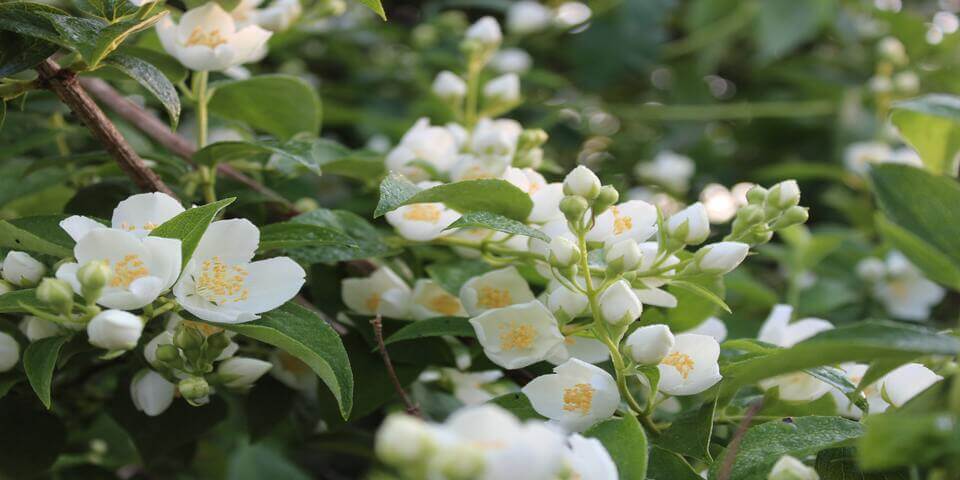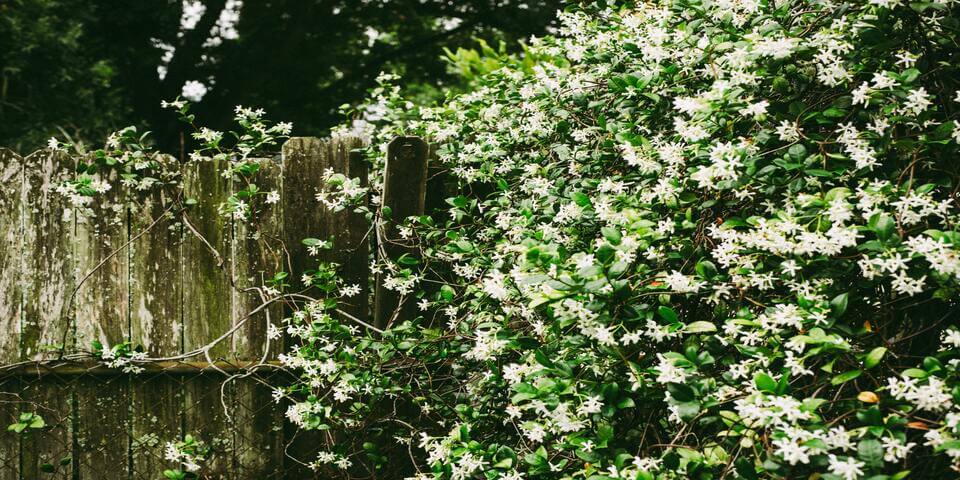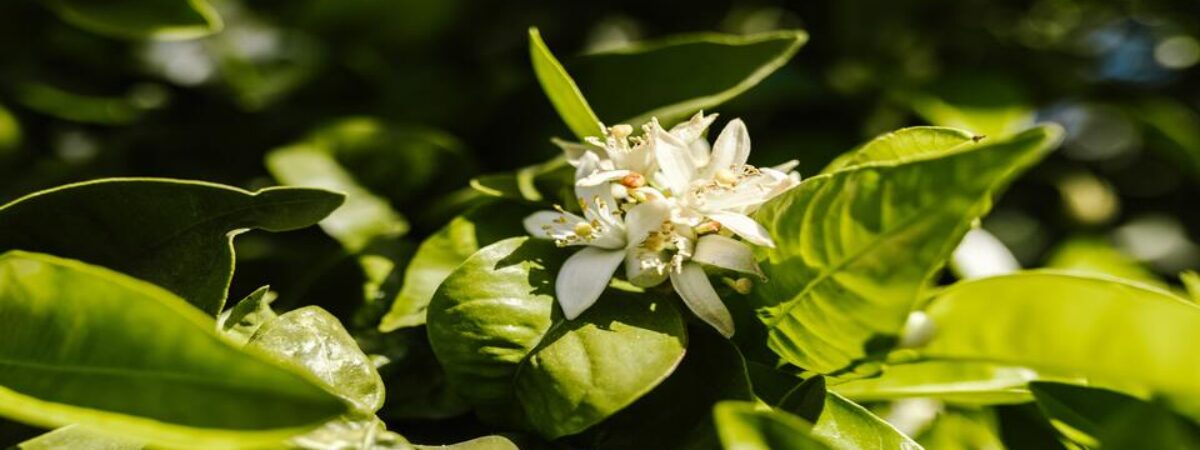If you have a big patch of land and want it to get covered with greens, Asiatic Jasmine is the way to go.
It is simply unbeatable when it comes to aggressive growth and covering a patch of land with green carpet in the shortest possible time even if the area is shady.
The icing on the cake is that Asiatic Jasmine is tolerant to both hot and cold climatic conditions, making it an evergreen vine.
What is Asiatic Jasmine?
Trachelospermum asiaticum or Asiatic Jasmine in a true sense is not a true Jasmine plant at all.
Botanically, Asiatic Jasmine is part of the Apocynaceae family and the true or common Jasmine plant belongs to the Oleaceae family and sometimes it creates confusion.
Under ideal conditions, the fragrance of its flowers is pretty much evident in the air, hence the second half of its name (jasmine).
While the common jasmine (Jasminum officinale) is native to Iran and known for its heavenly fragrance, the origin of Asiatic Jasmine can be traced to Asian countries like Korea, Japan, and India.
Though originated in Asia, Asiatic Jasmine has been thriving across America now.
A fast-growing vine with its ability to cover a large patch of land without any specific care, makes Asiatic Jasmine, a go-to vine in landscaping as a ground cover.
The dark green leaves of the plant can grow rapidly along the ground, fences, up the trees; virtually anywhere and it does not mind even if it’s a shady area.
This plant is simply unbeatable when comes to give your landscape a natural green cover with minimum time and effort.
History of Asiatic Jasmine
The history of Trachelospermum asiaticum dates back to 1846 when German botanists Philipp Franz von Siebold and Joseph Gerhard Zuccarini wrote extensively about the plant following their visit to Japan.
Initially, they had labeled the plant as Malouetia asiatica but later it has been reclassified as Trachelospermum asiaticum by noted Japanese botanist Takenoshin Nakai.
How to Propagate Asiatic Jasmine
Asiatic Jasmine does not grow from seeds. Dive in to see what are other propagation methods this plant.

Propagation from cuttings
Propagating this plant from cuttings is one of the best methods to grow the plant.
Take about a 5-6 inches of cutting from the tip of the plant. Strip leaves if any from the end of the cutting and dip the end into some rooting hormone for better results.
The plant thrives on almost all soil provided the drainage is good.
Take a small pot filled with either damp sand or soil and place the cutting into the pot.
To retain moisture, cover the pot with a plastic bag, and do not forget to water it regularly. Place the pot in an area that is shady or gets indirect sunlight.
You can also propagate the cutting in water. The cutting can be placed into a glass of water or a bottle just after dipping in the rooting hormone.
It takes about a month or so to develop roots. After roots are developed, it can be transplanted to another pot filled with potting soil.
Finally, it would take another 4 weeks for the rooted cuttings to be ready for transplantation to the ground.
Propagation from seedlings
You can get a green carpet faster if you start propagating or transplanting this plant from seedlings. Place each plant about 8 to 10 inches apart for a more thicker green cover.
Initially, water the plants about 3 times a week for a month and then once per week for the next couple of months for better results.
Propagation from roots
This method is also called layering. Asiatic Jasmine most of the time forms clumps of roots along the stemp while it grows.
You can simply cut off that root and put it in any medium of your choice to let the plant grow as an independent plant.
How to Grow Asiatic Jasmine
Growing any plant successfully requires a certain level of understanding about the soil needed, requirement of sunlight, fertilizers etc.
Let’s dive in to see what it takes to grow successful Asiatic Jasmine vines.

Soil
As we had discussed before, Asiatic jasmine thrives on almost all kinds of soil provided soil is well-drained with a pH in the range of 5.5 to 7.0.
It grows even more rapidly in the soil with adequate organic content.
This is a very sturdy plant, so you can plant it in shady as well as full sun areas without any restriction whatsoever.
If it gets really hot during summer, periodic showering of the plant is the way to go.
Water
These vines are drought tolerant and need moderate watering under normal circumstances to grow fairly well.
However, if you are in a place where you experience frequent rain, then you can afford to water the plants less frequently.
On hot summer days, you might have to water them at regular intervals.
Fertilizer
Asiatic Jasmine grows fairly rapidly without needing any kind of fertilizer as long as the soil is well drained and contains a high percentage of organic content.
However, if you want faster growth, you can apply a slow-release of NPK 10-10-10 fertilizer at the time of the growing stage.
Start applying the slow-release fertilizer once a month initially and when the plant is established, limit it to once a year.
Most Asiatic jasmine vines do well without any fertilizer also.
Best Growing and Caring Tips
This plant is not very attention-seeking as long as its needs are taken care of.
- Always use well-drained organic-rich soil
- Place it in full sun or shady area
- Shower the plants regularly during hot summer days
- Use a moist and warm environment to foster growth
- Usage of balanced fertilizer if needed
Cultivars to choose
Though most of the Trachelospermum asiaticum that grows are generic but over the years few cultivars have been developed by breeders.
Snow-N-Summer
This cultivar has been developed by Monrovia.
This is a very interesting cultivar. It produces beautiful pink foliage to start with, slowly turns white and matures further into variegated white and green.
The plant bears creamy yellow flowers.
Goshiki
This cultivar does really well during winter as well. Once matured, leaves turn out to be yellow with green strips.
Gold Brocade
This cultivar is from Japan. It starts out as variegated foliage of red and orange and at maturity, turns gold and deep green, hence the name Gold Brocade.
Summer Sunset
This cultivar does extremely well under sun than all other cultivars. Once matures, it provides vibrant yellow and green foliage.
How to prune and maintain Asiatic Jasmine

Asiatic Jasmine is a very aggressive plant and grows rather rapidly. If left unattended, it has the potential to be very invasive.
So periodic pruning is probably the most important maintenance that this plant needs.
If you have a large area, you can even use a lawnmower to check the spread of the Asiatic Jasmine vines. In an ideal condition, a normal pruner also does the job well.
Periodic pruning and whacking away of plant ends always encourages the plant to branch out more and thus providing a thicker carpet area.
How to manage diseases and pests
Asiatic Jasmine is a fairly disease-free and pest-free plant. You will hardly see any severe infection.
In rare cases, you might see some fungal infection caused by Cercospora that produces leaf spot. It can be treated with fungicide.
Last words
When it comes to providing solid ground cover, nothing can beat Asiatic Jasmine. It thrives in shady areas where no other plants would even survive.
This is absolutely drought tolerant, frost tolerant, free of any disease or pest and gives you an amazing green cover.
If you have drought tolerant plants like succulents, cacti, then you will love this plant to adorn your garden.
Do share with us your experience of growing Asiatic Jasmine vines.
You may also like to read
Asiatic Jasmine Vines: How to Prune and Control Asiatic Jasmine






